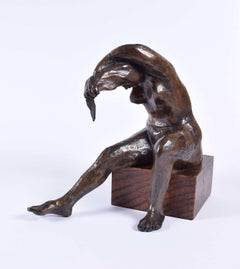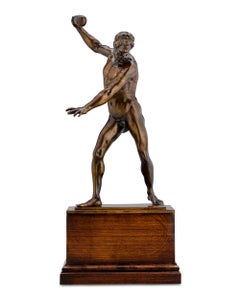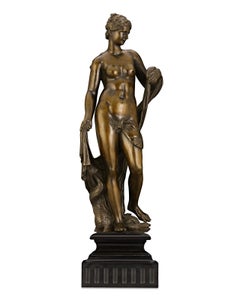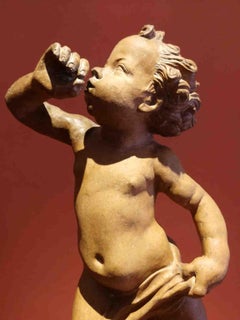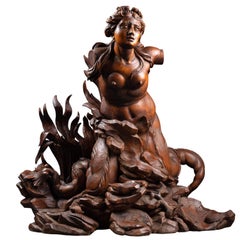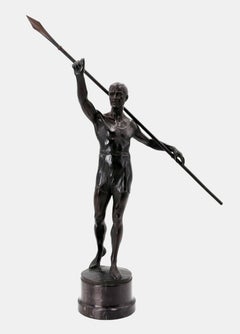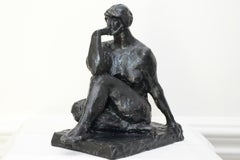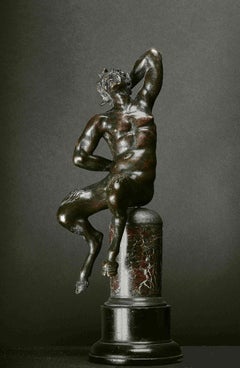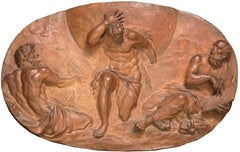17th Century Nude Sculptures
to
1
2
3
1
Overall Width
to
Overall Height
to
16
80
372
660
8
13
29
31
4
10
26
23
41
33
4
6
6
5
4
3
2
1
1
4
3
2
1
1
4
2
Period: 17th Century
Michael Ayrton 'Girl Wringing out her Hair' patinated bronze nude sculpture
Located in London, GB
Michael Ayrton (1921-1975)
Girl Wringing out her Hair
Patinated bronze, 1962
26cm in height
Michael Ayrton was a British artist and writer, renowned as...
Category
17th Century Nude Sculptures
Materials
Bronze
Labors of Hercules Bronze Sculpture, 17th Century
Located in New Orleans, LA
A rare example of late Renaissance sculpture, this impressive Italian bronze captures one of the greatest divine heroes of myth and legend: Hercules. The figure is rendered with stun...
Category
Baroque 17th Century Nude Sculptures
Materials
Bronze
Bronze of Amphitrite after Michel Anguier
Located in New Orleans, LA
After Michel Anguier
French 1612-1686
Amphitrite
Bronze
This remarkable bronze masterpiece was cast after a High Baroque masterwork by French sculptor Michel Anguier. After traini...
Category
Baroque 17th Century Nude Sculptures
Materials
Bronze
Artista fiorentino del XVII secolo da Verrocchio putto fontana in terracotta
Located in Florence, IT
Questa statua in terracotta in eccellente stato conservativo considerata l'età e la fragilità del materiale, raffigura un putto nell'atto di soffiare, colto in una posa di intenso p...
Category
Renaissance 17th Century Nude Sculptures
Materials
Terracotta
Putto in legno dorato reggi candela barocco italiano
Located in Florence, IT
One flame candle holder putto made of gilded wood.
Those kind of objects were present in churches or noble villas, specially during the Baroque times.
The base is not coeval.
Category
Baroque 17th Century Nude Sculptures
Materials
Gold
A late 17th Italian carved limewood figure of Mermaid, circle of Filippo Parodi
Located in PARIS, FR
A late 17th c. Italian carved figure of Mermaid,
Circle of Filippo Parodi (Genoa, 1630 – July 22, 1702)
Dimensions: h. 29.13 in, w. 30.31 in, p. 18.9 in (at the base)
Magnificent Italian Baroque sculpture depicting a mermaid seated on the rock.
All the virtuosity of the sculptor unfolds in this carved group. The fantastic creature is featured seated, the upper part of the body darting forward, the head looking upwards. Sophisticated hairstyle with rows of pearls intertwined in her hair, her loose locks fly in the wind and bring movement to the whole sculpture.
The wide-open eyes with hollowed-out pupils make it possible to follow the mermaid's gaze, towards the sky. The half-open mouth further magnifies this bewitching and seductive attitude.
Its long double tail ending in fins wraps on either side of a rocky mound strewn with objects evoking the underwater world: seashells and shells, branches of coral.
The ornamental richness combined with the great care taken in its execution make it a work in which the splendor of Italian Baroque art unfolds in such characteristic scenic movement.
The composition betrays a strong influence from Filippo Parodi, the leader of Genoese Baroque sculpture, and points to an artist from his circle.
Our sculpture was probably part of a decorative monumental palace.
The iconographic theme evoking the marine world finds its application in the numerous fountains and artificial grottos, designed in Italian palaces at the turn of the 17th and 18th centuries.
Giacomo Filippo Parodi (Genoa 1630 – July 22, 1702) was an Italian Baroque sculptor of the Genoese school, who introduced Bernini's aesthetic to Genoa.
In his youth fathers a first apprenticeship with a carpenter, he went to Rome where he became a pupil of Bernini.
He had the opportunity to admire in person the works and style of the French sculptor Pierre Puget...
Category
Baroque 17th Century Nude Sculptures
Materials
Wood
$21,087 Sale Price
20% Off
Related Items
Javelin thrower / - Roman present -
By Franz Iffland
Located in Berlin, DE
Franz Iffland (1862 Tempelhof - 1935 Berlin), Javelin thrower, after 1910. Olive-black patinated bronze with cast plinth mounted on a white-veined black marble base (7 cm high). Tota...
Category
Art Deco 17th Century Nude Sculptures
Materials
Bronze
$2,396 Sale Price
20% Off
H 24.02 in W 10.24 in D 9.85 in
Woman Seated A Bronze Sculpture of a Woman by Charles Rumsey
Located in Brookville, NY
The bronze sculpture of a woman by Charles Rumsey is undated, but was created at a point in his career where he began to transition from realism to more modern, looser depictions of ...
Category
American Modern 17th Century Nude Sculptures
Materials
Bronze
$6,000
H 10.5 in W 11 in D 6 in
Unveiling - Sculpture by Maryam Pezeshki - 2021
Located in Roma, IT
Unveiling is a contemporary artwork realized by Maryam Pezeshki in 2021
Terracotta sculpture.
Original title: Svelamento
Maryam Pezeshki was born in Tehran on August 18, 1977. SHe began to paint at the age of three. Her first painting was a Pinocchio. Participate in national and international painting competitions and festivals among Asian and Iranian children, winning first prize each time. At the age of ten she participated in a television program entitled "Little Great Artists". At the age of fourteen she won the prize for the best drawing and sculpture among Iranian teenagers, and she enrolled in the artistic high school, continuing to do her first personal exhibitions of sculpture, painting and drawing. From the age of seventeen to nineteen she won the national prize for best sculpture at the youth festival for three consecutive years. At seventeen he enrolled at the University of Art in the graphics sector and at twenty-one he graduated with full marks. In the same year she began studying for the master of graphics and managed to be among the seven students admitted. At the age of twenty-five she finished his studies and won a competition for teaching drawing and sculpture at the University of Art. In the meantime, visit the European and Indian museums...
Category
Contemporary 17th Century Nude Sculptures
Materials
Terracotta
$3,594
H 14.57 in W 7.88 in D 7.88 in
Large George Aarons Terracotta Sculpture Relief Art Deco Plaque WPA Artist
Located in Surfside, FL
Two Figures (Mother and son)
9" x 17" terracotta sculpture, signed lower left mounted to wood panel, 15 1/2" x 23 1/2"
George Aarons (born Gregory Podubisky, in St. Petersburg, Russ...
Category
Art Deco 17th Century Nude Sculptures
Materials
Wood, Terracotta
$2,200
H 15.5 in W 23.5 in D 1 in
1961 Coty Award Plaque Kenneth Hairdresser Jacqueline Onassis Bronze Fashion
Located in New York, NY
1961 Coty Award Plaque Kenneth Hairdresser Jacqueline Onassis Bronze Fashion
Bronze on wood. The wood plaque measures 12 3/4" by 20 3/4 inches. The bronze plaque itself is 13 3/4 x 8 3/4 inches and the the bronze inscription, which reads "COTY, American Fashion Critics Special Award 1961 to KENNETH of LILY DACHE...
Category
American Modern 17th Century Nude Sculptures
Materials
Bronze
The golden Horse by Helle Crawford, Contemporary bronze horse animal sculpture
Located in DE
Even though Helle Rask Crawford often refers to classic myths in her sculptures, sh is not a classical sculptor in the neoclassical sense. Rather, Helle Crawford could be defined as ...
Category
Contemporary 17th Century Nude Sculptures
Materials
Gold, Bronze
$5,032
H 23.63 in W 15.75 in D 7.88 in
Profundus Bronze Sculpture Nude Boy Contemporary Male Figure Marble Stone
Located in Utrecht, NL
Profundus Bronze Sculpture Nude Boy Contemporary Male Figure Marble Stone
Wim van der Kant (1949, Kampen) is a selftaught artist. Next to his busy p...
Category
Contemporary 17th Century Nude Sculptures
Materials
Marble, Bronze
$16,454
H 22.05 in W 22.05 in
Yellow Swimmer 2 Large - Handmade Modern Glazed Ceramics Sculpture, Man Portrait
Located in Salzburg, AT
The sculpture is signed below, inside
Tomasz Bielak born in Lublin in 1967. He graduated of The Academy of Fine Arts, Painting and Graphics Design Department in Gdańsk, in 1994....
Category
Contemporary 17th Century Nude Sculptures
Materials
Ceramic, Glaze
$2,036
H 9.45 in W 9.45 in D 7.49 in
Sculpture Terracotta Female Nude From Marcel Bouraine (1886-1948)
Located in Saint-Ouen, FR
Sculpture Terracotta From Marcel Bouraine (1886-1948)"
Original terra cotta sculpture of Marcel Bouraine
Naïade of the 1930's Signed Bouraine
On the ...
Category
Academic 17th Century Nude Sculptures
Materials
Terracotta
$5,511
H 23.63 in W 15.75 in D 15.75 in
The Rape of Sabine Iconic Bronze Sculpture 1930
Located in Rome, IT
Fine Group of Sculptures in Bronze after Jean de Boulogne (Giambologna)
The torturously twisting Rape of the Sabine Women is one of the finest and most technically difficult sculpt...
Category
Mannerist 17th Century Nude Sculptures
Materials
Bronze
$6,709 Sale Price
30% Off
H 35.44 in W 8.27 in D 8.27 in
The Rudder, Terracotta, 1930s
By Ugo Cipriani
Located in Saint Amans des cots, FR
French Art Deco terracotta sculpture by Ugo Cipriani (1887-1960), France, 1930s. A man operating a rudder. Measurements : Width : 31"(79cm), Height : 16.7"(42.5cm), Depth : 8.7"(22cm...
Category
Art Deco 17th Century Nude Sculptures
Materials
Terracotta
Torso of a Woman
Located in PARIS, FR
Torso of a Woman
by Marcel GIMOND (1894-1961)
Avery fine nuanced brown chamotte sandstone sculpture
raised on a dark grey marble base
signed on the arm with the monogram "MG" for Marcel Gimond
inscribed with the monogram "GS" for Georges Serré
stamped by the galerie Rouard
France
1927
total height 50 cm
width 20,5 cm
depth 20 cm
After a model by Marcel Gimond, this bust was made in 1927 by Georges Serré at the Manufacture de Sèvres, sold exclusively by the Rouard Gallery, and exhibited the same year at the Paris Fall Fair (Salon d'Automne).
Reproduced in "Sculpteurs nouveaux, Marcel Gimond", Paul Fierens, Nrf, 1930, cover.
Biographies :
Marcel Gimond (1894-1961) was a French sculptor. He studied in Lyon, then at the School of Fine Arts in Lyon where he graduated in 1917. Finally he arrived in Paris the same year and settled in Marly-Le-Roi. Student of Aristide Maillol, he also met Raoul Dufy and Auguste Renoir. Gimond worked with Maillol until 1920, and left him to settle in Paris and regain his independence. He then moved into Renoir's former studio, made available by Jean Renoir. He exhibited at the Salon des Indépendants and the Salon d'Automne in 1922. In 1940, Gimond left Paris to settle in the South zone, in Lyon, then in Aix en Provence; He spent his summers at Saint-Félicien, at the house of poet Charles Forot.
At the Liberation, in 1944, he returned to Paris and his workshop rue Ordener, he left only a few months before his death. From 1946 to 1960, he directed a workshop at the Ecole des Beaux-Arts in Paris. Marcel Gimond was known for his busts of political and artistic personalities. He also owed two bas-reliefs located in the lobby of the newspaper "L'Humanité", in tribute to Marcel Cachin and Gabriel Péri.
Georges Serré (1889-1956) was a French ceramist. He worked at the Sèvres factory until 1914, when he was mobilized to go to war. He then went to Indochina where he taught ceramics at the art school of Bien-hoa for five years. On his return to France, he moved to Sèvres, rue Brongniart, but encountered difficulties in producing his works, until the intervention of the ceramist Emile Decoeur who obtained him help to build an oven for firing his ceramics. It was Georges Rouard and his gallery located on avenue de l'Opéra in Paris, who had noticed him at the International Exhibition of Modern Decorative and Industrial Arts of 1925, which presented him during his "exhibitions of contemporary French artisans".
Georges Serré's taste for these sandstones came to him, among other things, from Khmer sculptures...
Category
French School 17th Century Nude Sculptures
Materials
Terracotta
Previously Available Items
Italy, early 17th century - Seated Faun - Bronze
Located in Paris, Île-de-France
Unknown Artist (Italy, early 17th century)
Seated Faun
Bronze on a marble base (later), 32 cm in height
Provenance:
Private collection
This bronze depicts a faun, a mythological figure from ancient Rome often associated with nature and fertility, embodying both human and animal attributes. The faun is portrayed here in a dynamic posture, seated on a marble base, which, though added later, enhances the sculptural dimension of the piece. His muscular and tense body seems to capture a moment of jubilation or exuberant pleasure, as evidenced by his upturned face and open mouth in an ecstatic smile. This expressive gesture, along with the casual positioning of his raised arm behind his head, evokes the freedom and hedonism traditionally associated with these mythological creatures.
The quality of the bronze craftsmanship is remarkable, particularly in the muscular details and the expressiveness of the face, signs of technical mastery typical of late Renaissance and early Baroque Italian sculpture. The faun's legs are muscular but also marked by hooves, emphasizing his hybrid nature, half-human and half-animal. This hybridity reflects an iconographic tradition in which fauns are often associated with debauchery and wild living, removed from human society.
Seventeenth-century Italy, particularly Rome and Florence, was a hub of prolific artistic production, with artists such as Gian Lorenzo Bernini and Alessandro Algardi...
Category
Renaissance 17th Century Nude Sculptures
Materials
Bronze
Hercules carrying the World, a sculpture after Annibale Carracci's fresco
By Annibale Carracci
Located in PARIS, FR
This vigorous terracotta was inspired by a fresco created by Annibale Carracci to decorate the ceiling of the Camerino Farnese, a room on the ground ...
Category
Old Masters 17th Century Nude Sculptures
Materials
Terracotta
H 9.82 in W 16.13 in D 2.75 in
Bruno Innocenti, Female Nude, 1966-1967, wood, signed and dated
Located in Florence, IT
From the 1950s Bruno Innocenti started being interested in wood sculpture. He experimented new forms, modeling the figures in order to adapt them to the pre-existing movement of the ...
Category
Post-War 17th Century Nude Sculptures
Materials
Wood
H 60.24 in W 18.12 in D 11.82 in
Recently Viewed
View AllMore Ways To Browse
Walter Henry Sweet Painting
Warhol Kimiko Powers
Warhol Lincoln Center Ticket
Wedding At Cana
William Blackman
William Dunlap
William Edward Millner
William H Clapp
William Lester Stevens Rockport In Winter
William Watson Jnr
William Yeaman
Xavier Valls
Zev Daniel Harris
Zhiwei Tu
1983 Americas Cup Poster
19th Century Art Borzoi
Aaron Kilpatrick
Adolphe Alexandre Lesrel
